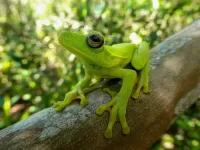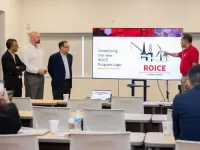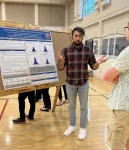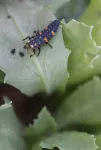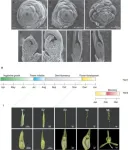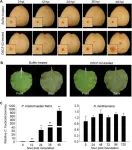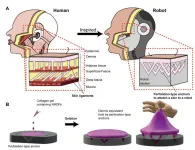(Press-News.org) UNIVERSITY PARK, Pa. — Frogs have maintained a surprising diversity of light-sensing proteins over evolutionary time, according to a new study led by a Penn State researcher. Light-sensing proteins, called opsins, enable vision in sighted animals, and are responsible for many more biological functions like regulating circadian rhythms. The researchers explored the evolution of nonvisual opsins in frogs, finding that most modern species examined in this study retained a shocking number of these proteins.
The findings were published in the June issue of the journal Molecular Biology and Evolution.
“When we think about sensory biology, vision tends to dominate our understanding of light perception,” said Jack Boyette, doctoral student in the Department of Biology at Penn State and lead author on the paper. “But nonvisual light sensitivity has myriad other biologically critical functions, like calibration of circadian rhythm, melatonin release, pupil response, and detection and response to seasonal changes. These functions are all initiated by nonvisual opsins.”
Nonvisual opsins are ubiquitous throughout the animal kingdom and are expressed in multiple tissues within and outside of the eye. Despite their broad importance, the researchers said these nonvisual opsins are relatively understudied. Frogs, the researchers said, provide an opportunity to study the proteins under diverse ecological conditions.
“Frogs are cool because different species can live in the water, on land, in trees or even underground,” Boyette said. “This gets further complicated by things like activity period — a lot of frog species are active at night, but some are active during the daytime. As you can imagine, all these different habitats have very distinct light environments, which has implications for the evolution and the function of sensory systems.”
To investigate the evolution of opsin diversity in frogs, the researchers combined genetic data from transcriptomes — the genetic sequences of all genes expressed in an organ — from the eyes of 81 frog species with publicly available genomes and multi-tissue transcriptome data from 21 additional species. These 102 species provided a broad sampling of frogs with different ecological adaptations.
“Whereas the common ancestor of tetrapods — four legged creatures that include mammals, amphibians and reptiles — likely had 18 opsin genes, several groups including mammals and snakes have lost many opsin genes through the course of evolution,” Boyette said. “Researchers have hypothesized that these groups underwent a nocturnal bottleneck over the course of their evolution, where they transitioned to nocturnal lifestyles and essentially lost the need for broad spectral sensitivity, which nonvisual opsins confer.”
Frogs are also an ancestrally nocturnal group, so the researchers expected to find reduced nonvisual opsin diversity in frogs. Remarkably, the frog genomes assessed in this study contained all 18 ancestral vertebrate nonvisual opsins and four of five ancestral visual opsins. This surprising finding may result from complex life histories, according to Boyette.
“Within the lifetime of a single animal, many frog species transition between drastically different light environments,” Boyette said. “Even though a lot of adult frogs are nocturnal, that's not necessarily true of the larval tadpoles. And so, we can get adaptive decoupling between life stages, where adults may not be dependent on the broad spectral sensitivity conferred by a bunch of nonvisual opsins, but the larvae could be dependent on them. Meaning that for these frogs to survive, they need to maintain this nonvisual opsin diversity.”
Out of the 18 nonvisual opsins identified in the genomes, the researchers found 14 that were consistently expressed in frog eyes. In a subset of nonvisual opsins, they also found evidence of a type of natural selection called positive selection, in which new advantageous genetic variants are favored. The strongest signature of selection was in a gene called pinopsin, an opsin thought to be important for low-light photoreception in several types of animals.
Additionally, the researchers identified genetic differences in opsins between groups with differing ecologies and life histories. This could potentially indicate that frog nonvisual opsins have adapted to specific lifestyles or environments, Boyette said.
Boyette said he hopes that this research will inform future studies that test the explicit functions of nonvisual opsin genes in experimental settings.
“Although nonvisual opsins are found in a wide variety of animals, including humans, they are poorly understood,” Boyette said. “This study fills an important gap in our understanding of how opsins have evolved in vertebrates.”
Other members of the research team include Ryan K Schott, senior author, York University; Rayna C Bell, California Academy of Sciences and National Museum of Natural History, Smithsonian Institution; Matthew K Fujita and Kate N Thomas, University of Texas at Arlington; Jeffrey W Stretcher and David J Gower, Natural History Museum of London.
The Natural Environment Research Council, the U.S. National Science Foundation and the Natural Sciences and Engineering Research Council of Canada supported this research.
END
Unexpected diversity of light-sensing proteins goes beyond vision in frogs
2024-06-25
ELSE PRESS RELEASES FROM THIS DATE:
University of Houston strengthens commitment to clean energy with key partnerships
2024-06-25
HOUSTON, June 25, 2024 - The University of Houston, the energy university with multiple energy-focused research centers, last week signed two memorandums of understanding with industry partners Promethean Energy and Endeavor Management. The agreements formalize the partnership to address the challenges of repurposing offshore infrastructure for clean energy use.
Both companies will work closely with UH Energy, the University’s interdisciplinary energy initiative, and members of UH’s Repurposing Offshore Infrastructure for Clean ...
UT Arlington prioritizes undergraduate research to ensure student success
2024-06-25
Studies have shown that undergraduate students who participate in research activities under the guidance of a faculty member or mentor are more likely to finish college. That’s one of the reasons why The University of Texas at Arlington has tripled its investment in specific undergraduate research opportunities.
“Engaging students in original scholarship is time-intensive and expensive, but the outcomes are overwhelmingly positive, leading to more student success and an increase in the number of students interested in pursuing graduate school, including medical school,” said Kayunta Johnson-Winters, interim director of undergraduate research at UTA and an associate ...
Researchers identify a novel biomarker linked to renal cancer recurrence
2024-06-25
Researchers from the University of Michigan Health Rogel Cancer Center have discovered a biomarker that could help identify which renal cancer patients have a higher risk of recurrence.
The findings were published in JCO Precision Oncology.
Kidney cancer accounts for about 3-5% of all cancers; clear cell renal cancer makes up about 75% of all kinds of kidney cancers. Currently, treatment for clear cell renal cancer is determined based on the size and grade of the tumor and stage of overall disease.
But this “one-size-fits-all” approach isn’t always precise.
“We ...
Farmland weeds help to combat pests
2024-06-25
Leaving some weeds between crops can help to combat pests on agricultural land, according to a new study carried out by the University of Bonn. This step has particularly positive effects in combination with other measures: the cultivation of different types of crops and planting strips of wildflowers. The results have now been published in the Journal of Pest Science.
Intercropping, i.e. planting different types of crops on the same field has a number of benefits: The crops have different requirements and the crops face less competition than when grown in monocultures. This means that they make better use of the water and nutrients ...
The American Ornithological Society (AOS) announces its 2024 award winners for achievements in ornithological research by early-career professionals
2024-06-25
CHICAGO — June 25, 2024 — The American Ornithological Society (AOS) annually bestows research awards honoring early-career researchers for their ornithological research. This year’s early-career research awardees represent outstanding contributions to the scientific study and conservation of birds. The 2024 recipients will accept their awards at the 2024 AOS annual meeting (AOS 2024) this October in Estes Park, Colorado.
The AOS’s James G. Cooper Early Professional Award and the Ned K. Johnson Early Investigator Award are presented annually to recognize outstanding and promising ...
From sunspots to traffic jams: Explaining real-world patterns scoops major maths prize for Surrey professor
2024-06-25
A Surrey mathematician is the first ever UK-based winner of a prestigious international prize for his work to better understand patterns which contribute to a diverse range of phenomena, including stop-and-go traffic jams, weather fronts, sunspots and crime hotspots.
The T Brooke Benjamin Prize is awarded every two years by the Society for Industrial and Applied Mathematics (SIAM) – the world's largest applied mathematics society – for outstanding ...
Orchid awakening: Unveiling the hormonal choreography behind flower development
2024-06-25
A cutting-edge study has uncovered the complex hormonal and genetic interactions that dictate the seasonal flowering cycle of Cymbidium sinense, the Chinese orchid. This research sheds light on the enigmatic mechanisms of floral bud dormancy and its subsequent activation, offering new perspectives on the control of flowering times in plants.
Flower development in plants is a complex process influenced by various intrinsic and extrinsic factors. Hormones like gibberellin (GA) and abscisic acid (ABA) play pivotal roles in regulating this process. In many orchids, including the Chinese Cymbidium, flower bud dormancy ...
EMBO Gold Medal awarded to Elvan Böke
2024-06-25
EMBO awards the EMBO Gold Medal 2024 to Elvan Böke, group leader at the Centre for Genomic Regulation (CRG) in Barcelona, Spain. The award recognizes researchers under the age of 40 for outstanding contributions to the life sciences in Europe. The awardee receives a gold medal and a bursary of 10,000 euros.
Early-stage oocytes are exposed to biological and environmental factors for decades, which can make them susceptible to cumulative damage. At the same time, the growth phases associated with oocyte maturation ...
Battling anthracnose: Unearthing the plant's arsenal against pathogenic fungi
2024-06-25
A pivotal study has shed light on the intricate mechanisms of nonhost resistance (NHR) in plants, a critical defense against a broad spectrum of pathogens. By identifying and characterizing four novel core effectors from the pathogen Colletotrichum fructicola, researchers have unveiled key players in the plant Nicotiana benthamiana's immune response. This discovery is set to transform approaches to plant disease management, offering a pathway to bolster crops against devastating fungal infections.
Plant diseases caused by pathogens like Colletotrichum ...
Robots face the future
2024-06-25
Researchers have found a way to bind engineered skin tissue to the complex forms of humanoid robots. This brings with it potential benefits to robotic platforms such as increased mobility, self-healing abilities, embedded sensing capabilities and an increasingly lifelike appearance. Taking inspiration from human skin ligaments, the team, led by Professor Shoji Takeuchi of the University of Tokyo, included special perforations in a robot face, which helped a layer of skin take hold. Their research could be useful in the cosmetics industry and to help train plastic surgeons.
Takeuchi is a pioneer in the field of biohybrid ...
